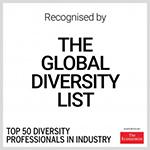
Exploring The Many Layers Of Skewed Gender Balance At Work How to practice inclusivity on the ground
Having worked in the gender space for some time now, I must admit that significant advances have taken place for women at work over the last century since ILO adopted the first convention (1919) on women and work.
While women continue breaking the glass ceiling in almost all the traditional male bastions, achieving gender balance still requires active effort.
Achieving gender balance at work has been complex and slow. While some organizations focus on increasing diversity numbers at the entry level, we are yet to see balance across leadership levels. The leaky pipeline has been a concern that organizations are grappling with. Most women manage the dual responsibilities of home and work. This is already stressful and when parenting responsibilities come up, we see women drop out from their careers to prioritise family and child care.
Apart from this, there are unconscious gender biases, sexual harassment, and stereotypical expectations that make it all the more difficult for women to access and claim their legitimacy to lead.
I want to focus on a particular sublime observation that I have grown to believe is impacting gender balance at work. In search of diversity, and with the intent of equality, many organizations have started reserving a certain percentage of their leadership positions for women and rolling out specific programmes to place women in leadership roles. Increasing the number of women leaders is important and needs urgent focus, but assuming that this will result in propagating cognitive diversity at the leadership level, is far from realistic. Only focusing on diversity is not enough, it’s important to practice inclusivity on the ground.
As a women leadership consultant, I get to coach and work with senior women leaders across different industries. Mostly, I find these women leaders subscribing to the prevailing leadership paradigm that is born out of patriarchy and rooted in militaristic thinking; drastically overemphasizing masculine values, and in some manner, expressing contempt for most feminine qualities. Hence, even today, I see a number of women leaders approaching leadership as ‘men in skirts’, trying twice as hard to overemphasize their masculine traits, while most male leaders remain tragically disconnected from this vital aspect of their personalities – their innate feminine qualities.
In my conversation with many women leaders across levels, I see them constantly “Minimize” themselves at work. For example, they start sharing their point of view by statements like “I have a small suggestion to make”, “I am sorry to take more time but.” Women look at themselves as a burden than a value-adding contributor when they make these kinds of statements and optically undervalue their own thoughts themselves. As we incorporate more and more women into the workforce or at leadership ranks it is important that we build psychological safety.
Across the globe, we see men and women leaders struggling to ‘fit in’ to gender-defined molds rather than conjuring up the courage to be their authentic self. This self-deceptive act is responsible for the inordinate crisis in leadership today – inauthentic leaders failing to inspire positive and sustainable action.
Globally, we are in a transition period where masculine and feminine roles are being redefined and re-arranged. While we are altering the masculine and feminine roles based on the idea of equality, we need to understand that ‘male’ and ‘female’ are biological identities, which are universal in nature and can’t really be changed.
Traditionally, across cultures, masculine qualities are associated with the left brain; they are task-focused and mostly driven by intellect, focus, passion, and logic. On the other hand, feminine qualities are all about the right brain; they are relationship-focused and mostly driven by feeling, inclusion, nurturing and intuition. The need of the hour is for men and women to transcend their traditional gender-defined roles, to evolve into holistic beings by integrating their inner masculine and feminine qualities.
Leaders need both masculine and feminine traits to be successful in today’s world. Great leaders, regardless of gender, work towards finding their own unique balance by integrating complementary forces – their internal masculine and feminine dimensions and valuing them equally.
Only increasing the number of women leaders at the top, who subscribe to the gender stereotypes, might not help in creating a more inclusive workplace. It is time to challenge the patriarchal approach to leadership and construct a milieu, which inspires leaders to evolve and operate from a position of authenticity. Senior leaders across disciplines need to build an acceptance for a different leadership paradigm; one which is much more inclusive, holistic and one, which will encourage minds to operate without fear. We need to see the emergence of great leaders across genders that endeavor to be more holistic and authentic, by leveraging the whole inner continuum of masculine and feminine traits based on the situation.
Our thinking shapes our behavior, and our behaviors determine the outcome we achieve. A fundamental transformation is needed in our way of thinking and expression. We all need to work towards building a mindset of acceptance and inclusivity and reflect the same in our workplace practices. When, as leaders, we are able to approach work from an internally integrated gender mindset that’s when workplaces will organically evolve towards implementing policies and practices, which help to improve the gender balance at work.
Amruta Choudhury is Head – Women Leadership Development at Interweave Consulting. She has 17+ years of experience in leading both corporate and HR practices for large and esteemed organizations like Infosys, ING and Max Life. She has a rich experience of working on global projects in the area of change management, organization design, coaching, career architecture & development, designing and facilitating learning interventions, employer branding, assessment development centre, diversity and inclusion and HR diagnostics. She is an advanced NLP Coach and passionate towards designing learning interventions for women. She has created her own unique model of coaching that integrates her understanding of Mindfulness to the coaching profession.

P.S – This blog was written for HR.com – Maximizing Human Potential and was published on https://www.hr.com/en/magazines/all_articles/exploring-the-many-layers-of-skewed-gender-balance_kogypk7j.html











